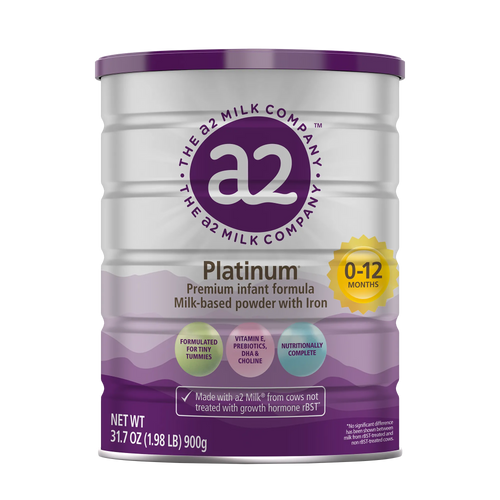Guide to Formula Fed Baby Poop
Reviewed by: Julie Ruelle, RD, LD
Navigating the world of baby poop might not have been part of your pre-parenthood dreams, but welcome to the most unexpected adventure of your life. If you are formula feeding your little one, understanding what's happening in those diapers isn't just a messy necessity—it's a key indicator of your baby's health and development.
Every diaper change is like decoding a tiny, somewhat gross, medical report. The color, consistency, and frequency of your baby's poop can tell you volumes about their digestive health, nutritional intake, and overall well-being. What might look like a random mess is actually your baby's way of communicating important information.
As a new parent, you're likely experiencing a mix of fascination and mild horror at the variety of formula fed baby poop you're encountering. From mustard yellow to greenish-brown, each shade and texture carries its own story. Understanding these signals can help you feel more confident and less anxious about your baby's nutrition and digestive process.
The Journey Begins: Newborn Poop Patterns
The first week of your baby's life marks an important transition in their digestive system. Your baby's first stool, called meconium, is a greenish-black, tar-like substance formed while your baby was still in the womb. As your baby begins digesting milk, their stool will transition to more regular formula-fed stools, showing their digestive system is adapting to formula feeding.
According to the American Academy of Pediatrics, formula-fed babies typically have one to four bowel movements daily during their first few months, though this can vary depending on the individual baby as their system adapts to processing formula.
Normal Consistency and Color: What to Expect
The consistency of formula-fed baby poop is generally firmer and more formed than that of breastfed babies. This difference occurs because formula takes longer to digest than breast milk, producing more solid waste products. Your baby's stools should have a paste-like texture similar to peanut butter, maintaining a relatively consistent form throughout the day.
Formula-fed baby poop typically ranges from mustard yellow to light brown. While color variations are common and can be influenced by formula type or iron content, monitoring for changes that might indicate health concerns is important.
Green-tinged stools may appear occasionally and are usually no cause for concern when your baby is otherwise healthy and feeding well. Understanding different baby poop colors is important as they can indicate various aspects of an infant's health and digestive process. Variations in stool color, such as shades of green, yellow, and brown, are typical and can be influenced by factors like diet or medications.
Different formulas can influence stool color due to their varying iron contents and protein sources. Some formulas' unique protein composition may result in stools that are lighter brown, which is also usually completely normal.
If you notice any significant or sudden changes in your baby's stool color or consistency, consult your baby’s healthcare provider to rule out any underlying issues.
Signs of Healthy Digestion in Formula-Fed Babies
How can you tell if your formula-fed baby's digestive system is functioning properly? Here are some key indicators to monitor:
- Consistency: Stools maintain a soft, formed texture without being watery or overly hard
- Frequency: Most formula-fed babies have bowel movements anywhere from one to four times a day, though this can vary from baby to baby
- Color Range: Stools appear in shades from yellow-brown to light brown or greenish
- Smell: A mild to moderate odor indicates proper formula digestion
- Timing: Bowel movements often occur after feedings due to the gastrocolic reflex
- Comfort Level: Baby passes stools without excessive straining or fussing and remains content between feedings
- Growth Progress: Steady weight gain according to pediatric guidelines
- Diaper Count: 6-8 wet diapers daily generally indicates proper hydration
Monitoring these characteristics helps ensure your baby digests formula properly. Regular, consistent bowel movements are a positive sign of your baby's growth and development.
If you notice significant changes in your baby's stool patterns, particularly in consistency or color, it's important to track these changes. Most variations are normal and temporary, but maintaining a log can help you discuss any concerns with your healthcare provider during or in between your regular check-ups.
How Bowel Movements Change as Your Baby Grows
Your formula-fed baby's pooping schedule will naturally evolve as they grow and develop. Here's what you can expect at different ages:
Newborn (0-1 month)
- Newborn’s usually have 1-2 stools daily, often after feeds
- Transitioning from meconium to regular formula-fed stools
- During the first few weeks, you can expect anywhere from 1-8 bowel movements daily
1-2 months
- 1-4 bowel movements per day*
- Pattern becomes more predictable
- Individual routine begins to establish
3-4 months
- May reduce to 1-2 daily movements*
- More consistent timing throughout the day
- Digestive system becomes more efficient
4-6 months
- Typically 1-2 movements per day*
- Firmer consistency as digestive system matures
- Patterns more established and predictable
6-12 months
- 1-2 movements daily*
- Texture changes with introduction of solid foods
- Stool characteristics reflect expanded diet
*Each baby develops their own unique schedule for bowel movements, which can vary significantly from day to day. The World Health Organization emphasizes that consistency and color are more important indicators of digestive health than frequency alone. As long as your baby is gaining weight appropriately and seems comfortable, their pattern is likely normal.
How Different Formulas Affect Your Baby's Digestion
Your baby's digestive system is uniquely sensitive during the first year of life, making formula selection key for their comfort and development. The characteristics of your baby's stool can be significantly influenced by the type of formula they consume. Research from the National Library of Medicine shows that different formula compositions can significantly affect stool characteristics and digestive patterns.
Standard Milk-Based Formulas
Standard milk-based formulas typically result in stools that closely resemble those of breastfed babies, though slightly firmer. These formulas contain proteins and fats designed to mirror the digestive process of breast milk, making them the most common choice for healthy infants. Your baby's digestive system generally adapts to standard formulas within the first few weeks of consistent use.
Specialized Formulas
Specialized formulas, including sensitive and hypoallergenic options, often produce different stool patterns that may concern new parents. These variations are usually normal and expected, as the modified proteins in these formulas digest differently. Depending on the formula's composition, stool may be slightly looser, darker, or have a different odor.
Understanding these variations can help you feel more confident about your baby's digestive patterns, but always consult with your pediatrician if you notice significant changes or if you're considering using a specialized formula. Specialized formulas should be introduced with professional guidance to ensure they're the right choice for your baby’s needs.
Understanding Formula-Fed Baby Constipation
While it's common for formula-fed babies to have less frequent bowel movements than breastfed infants, identifying true constipation requires looking beyond just the timing. Recent studies from the North American Society for Pediatric Gastroenterology show that approximately 30% of formula-fed infants experience constipation during their first year. This higher prevalence compared to breastfed babies is primarily due to formula's composition and how babies' digestive systems process it.
Key Signs of Baby Constipation
The most reliable indicator of constipation is the consistency of your baby's stool rather than frequency. Look for these signs:
- Hard, pebbly stools that resemble small clay balls
- Firm, formed stools that are difficult to pass
- Baby straining for more than 10 minutes without producing a bowel movement
- Decreased frequency with signs of discomfort
- Dark green stool (sometimes from iron supplementation)
Physical and behavioral changes often accompany constipation in formula-fed babies. Your baby may become notably fussy, draw their legs up to their stomach, or arch their back due to discomfort. Some babies may also experience increased spitting up or show signs of a hard, swollen belly. These symptoms, particularly when occurring together, may require medical attention, consult your baby’s pediatrician.
Common Constipation Triggers
Several factors can contribute to constipation in formula-fed babies:
- Introduction of solid foods: Your baby's digestive system must adjust to processing new textures and ingredients.
- Formula preparation: Using too much powder relative to water creates a concentrated mixture that may lead to constipation (amongst other issues). Always prepare formulas exactly as the label instructs unless advised otherwise by a healthcare professional.
- Environmental factors: Changes in routine, travel, or stress can affect your baby's bowel movements.
Understanding these triggers helps you take preventive measures and maintain your baby's digestive comfort.
Monitoring Your Baby's Bowel Movements
Keeping a simple log of your baby's bowel movements during the first few months helps establish what's normal for your little one. Track the frequency, consistency, and color of stools, noting any patterns or changes that emerge. This information proves invaluable during pediatrician visits and helps you quickly identify potential concerns.
Using baby poop pictures from reputable medical sites such as the Cleveland Clinic can also be helpful for understanding the various colors and textures of formula fed infant stool. These visual guides illustrate what is considered normal based on diet and developmental stages, emphasizing the importance of recognizing changes in baby poop for health monitoring.
Modern baby tracking apps may make monitoring bowel movements easier. Many parents find digital tracking tools help them spot patterns and changes more effectively than traditional paper logs. Remember that every baby develops their own unique schedule, and what's normal for one infant may differ from another.
When to Contact Your Pediatrician
While variation in bowel movements is normal, certain situations warrant medical attention. According to the Children's Hospital of Philadelphia, you should contact your pediatrician if you notice:
- No bowel movement for more than three days
- Signs of discomfort or very hard stools
- Black, white, or red-colored stools
- Blood in the stool, whether bright red or dark and tarry
- Watery stools occurring more than 8 times daily (could indicate diarrhea)
- Hard, pellet-like stools (might suggest constipation)
Watch for significant changes in stool consistency, especially if accompanied by other symptoms. These signs should never be ignored as they may indicate health issues that require medical assessment.
What Your Baby’s Poop Can Tell You
Understanding your formula-fed baby's digestive journey is more than just tracking diaper changes—it's about recognizing the intricate signals of their developing nutritional health. By observing color, consistency, and frequency, parents gain invaluable insights into their infant's overall well-being, transforming what might seem like a mundane task into a meaningful connection with their child's developmental milestones.
While every baby's digestive system is unique, the patterns of formula-fed infant poop reveal a fascinating narrative of growth, adaptation, and nutritional absorption. Beyond the immediate concerns of diaper contents, these early indicators offer a window into your baby's internal processes, highlighting the remarkable complexity of infant nutrition and the incredible resilience of their developing bodies.
Embracing this knowledge empowers parents to approach their child's digestive health with confidence, curiosity, and a deeper appreciation for the miraculous journey of early childhood development.
Visit a2 Platinum® for more feeding tips, expert advice, and first-year insights on infant nutrition.






